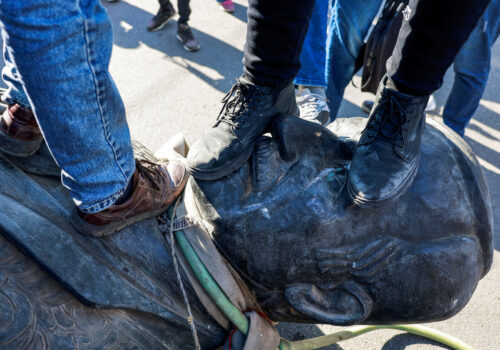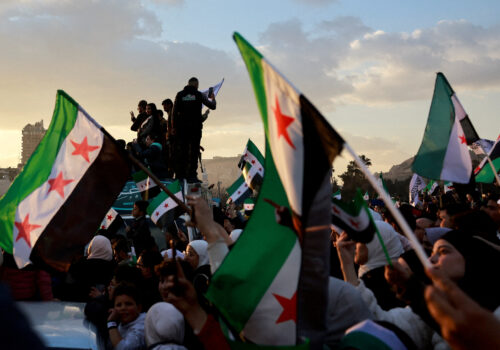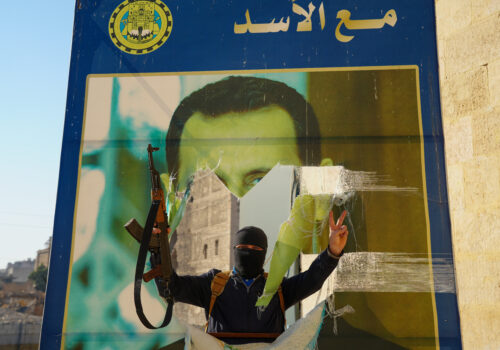To help build the new Syria, the US needs to better understand the Kurds and Arabs of the northeast
With the removal of the Assad regime, the new government in Syria now controls all parts of the country except for the northeast, where the Kurdish US partner force against the Islamic State of Iraq and al-Sham (ISIS) continues to hold sway. While it is common in international circles to hear the residents of northeast Syria described as ‘Syrian Kurds,’ the area has a predominantly Arab tribal population.
Understanding the demographics of this region is crucial to avoid significant US foreign policy mistakes that could impact regional security and lead to unforeseen consequences. Washington should take note of the complexities in the region and not be bound by the past as it engages its old partner in the Syrian Democratic Forces (SDF) and the new leadership in Damascus. The security of the entire region is at stake.
The demographics of northeast Syria
One of Syria’s two main economic arteries, the M4 highway runs across northeast Syria parallel to the Turkish border and extending toward Iraq. Northeast Syria can be divided into two regions: north and south of the M4.
The area south of the M4 is the heartland of Arab tribes in Syria, aside from a few Assyrian villages near Tal Tamr. The area north of the M4 is home to a mix of Arabs and Kurds, with minority populations of Assyrian Christians, Turkmen, and Circassians. For example, the city of Qamishli features a diverse demography. Out of its twenty-three neighborhoods, eight are predominantly Kurdish, six are predominantly Arab, two are primarily Christian, and seven are mixed. To the south of the city, the villages are almost entirely Arab.
SIGN UP FOR THIS WEEK IN THE MIDEAST NEWSLETTER
Another example can be found in the internationally renowned Kurdish town of Ayn al Arab (Kobane), which is not solely inhabited by Kurds. Kobane is home to various Arab tribes, including the Jubour tribe, Bani Said tribe, Omayrat clan, Adwan clan, and Henadi clan. Furthermore, people from the Turkmen tribes, such as the Arbaliyah, Turyaki, Qadirli, Qasimiliyah, Qazli, and the Qara Shaikhli clans, also reside in Kobane. Among the Kurdish population, several tribes are represented, including the Zirwar, Alaidan, Shadad Wawij, Zarki, Hefaydi, Bish Alti, Shaikhan, and Daydan clans.
According to Syria’s 2004 census—the most recent data available—the demographically mixed sub-districts north of the M4 highway had a population of 599,873. The ethnically diverse sub-districts reaching north and south of the M4 had a combined population of 378,151. Meanwhile, the almost homogeneous Arab sub-districts south of the M4 had a population of 1,721,132.
| Region | Subdistrict | Ethnic Majority | Population | Total |
|---|---|---|---|---|
| North of the M4 highway | Ayn al Arab | Kurdish | 81,424 | 599,873 |
| Shuyukh Tahtani | Kurdish | 43,861 | ||
| Tel Abyad* | Arab | 44,671 | ||
| Suluk* | Arab | 44,131 | ||
| Rasulayn* | Arab | 121,536 | ||
| Dirbasiyah | Kurdish | 55,614 | ||
| Amuda | Kurdish | 56,101 | ||
| Jawadiyah | Kurdish | 40,535 | ||
| Malikiyah | Arab-Kurdish | 112,000 | ||
| Across the north and south of the M4 highway | Ayn Issa | Arab | 40,912 | 378,151 |
| Qamishli | Arab-Kurdish | 232,095 | ||
| Qahtaniyah | Arab-Kurdish | 65,685 | ||
| Yarubiyah | Arab | 39,459 | ||
| South of the M4 highway | Dayr Hafir** | Arab | 34,366 | 1,721,132 |
| Maskanah** | Arab | 64,829 | ||
| Sarrin | Arab | 69,931 | ||
| Raqqa | Arab | 338,773 | ||
| Al-Karamah | Arab | 74,429 | ||
| Al-Sabkhah** | Arab | 48,106 | ||
| Al-Thawrah** | Arab | 69,425 | ||
| Mansoura** | Arab | 58,727 | ||
| Al-Jarniyah** | Arab | 31,786 | ||
| Kasrah | Arab | 63,226 | ||
| Deir Ezzour*** | Arab | *** | ||
| Suwar | Arab | 37,552 | ||
| Busayrah | Arab | 40,236 | ||
| Khasham | Arab | 28,718 | ||
| Diban | Arab | 65,079 | ||
| Hajin | Arab | 97,870 | ||
| Susah | Arab | 45,986 | ||
| Tel Hamis | Arab | 71,699 | ||
| Bir al-Helou al-Wardiyah | Arab | 38,833 | ||
| Tel Tamr | Arab | 50,982 | ||
| Hasakah | Arab | 251,570 | ||
| Al Hawl | Arab | 14,804 | ||
| Arishah | Arab | 30,544 | ||
| Shadadi | Arab | 58,916 | ||
| Markada | Arab | 34,745 |
**The SDF currently controls these subdistricts located on the western side of the Euphrates River.
***The population count of the Arab Deir Ezzour subdistrict, which reaches across the Euphrates River and is mostly within non-SDF-held areas, has not been included as the official data does not reveal the population on the eastern side of the river.
The goal of using the 2004 census is not to make a definitive statement, but to have a reference point. The census recorded a population of 2,488,818 in areas currently held by the Kurdish-dominated SDF. Of this total, 277,535 individuals lived in Kurdish-majority towns and villages. If you count all of those people as Kurds and add half of the populations of Qamishli, Qahtaniyah, and Malikiyah, the total count amounts to 482,425 people—meaning that only about 19 percent of the total residents of SDF-held regions were Syrian Kurds, according to the 2004 census. Since Syrian Kurds historically have a lower birth rate compared to the Arab tribes in the region, the current percentage of Syrian Kurds has likely decreased even further than this rough reference point.
The Syrian Kurds
Like any ethnic group, Syria’s Kurds have a range of political, religious, and tribal orientations. The prominent historic Kurdish political movement in Syria is the Syrian Kurdish National Council (KNC), which has close ties to Iraqi Kurdistan and the Kurdistan Democratic Party. The KNC’s military arm, the Rojava Peshmerga, is based in Iraqi Kurdistan and is trained by the Zarawani Peshmerga, who have received military training from the United States. In Iraq, both the Zarawani and Rojava Peshmerga fought against ISIS. The KNC has officially been part of the Syrian opposition.
The Democratic Union Party (PYD) was established as the Syrian branch of Turkey’s Kurdistan Workers Party (PKK), which is classified as a foreign terrorist organization by the United States, NATO, the European Union, and Turkey. The PYD is a relatively new political entity in Syria. Its military wing, the People’s Protection Units (YPG), was formed in 2012 by PKK veterans before the Assad regime transferred control of Kurdish areas in northern Syria to them. This exchange aimed to silence the Kurdish opposition and prevent a united front between Arabs and Kurds in the region. Several politicians from the KNC have been arrested, exiled, or killed by the YPG.
Many Syrian Kurds view the PYD and YPG as extensions of the PKK, with its main decision-making power coming from cadres based in the Qandil Mountains of Iraqi Kurdistan. This has led to perceptions that the PYD/YPG is ultimately a Turkish-Kurdish organization rather than Syrian. Notably, the general commander of the SDF, Mazloum Abdi, is also a PKK veteran who was once stationed in the Qandil Mountains.
The United States, France, and the United Kingdom are currently facilitating talks between the SDF and the KNC to establish a joint Kurdish committee that will be sent to Damascus. At the same time, the KNC has sent a delegation to Damascus to engage with civil society and local leaders. Additionally, the SDF recently held its first meeting with the new government in Damascus. It’s important to note that a previous US-brokered intra-Kurdish mediation effort in 2020 failed due to the SDF’s resistance to any power-sharing arrangements, the burning of KNC offices, and the refusal to allow the Rojava Peshmerga to enter Syria.
The Arab tribes
After the United States formed a partnership with the YPG-dominated SDF, Kurdish forces made significant advances into areas that were previously held by ISIS. The Arab tribes in northeastern Syria—of which the primary groups are the Uqaydat, the Baqqara, the Jubour, the Shammar, the Tayy, and the Bushaban—have lived under the authority of the SDF. Until recently, several foreign actors, including Turkey, Russia, Iran, and the United States, have co-opted these tribes to further their own interests.
This had major ramifications for internal tribal relations and tribal identity. With some tribal chiefs aligning with outside powers, association at the tribe level decreased in favor of stronger bonds with the clan or even greater family level.
Some tribal chiefs were part of the Syrian revolution, working with the Syrian opposition and Turkey. However, these tribal chiefs were in exile until the collapse of the Assad regime and have now returned to areas on the western side of the Euphrates River. Another group of tribal chiefs feared the Assad regime and established a pragmatic relationship with the SDF as the lesser evil. Lastly, one group of tribal chiefs remained loyal to the Assad regime or recently aligned with the Assad regime and Iran in a bid to free their homelands from the YPG.
After the tribal uprising in August and September 2023 failed to secure US support for their control over Arab tribal areas, several tribal chiefs expressed frustration. Contrary to their expectations, the United States did not intervene to prevent the SDF from brutally suppressing the uprising. In their bitterness, many tribal leaders viewed cooperation with the Assad regime and Iran as their only viable option. Under Iranian supervision, many tribal chiefs, including uprising leader Ibrahim Al-Hafel of the Uqaydat tribe, were integrated into the tribal military units of the Assad regime. This situation mirrored the mistake made in Iraq when the United States abandoned the Sahawat Movement.
With the establishment of a new government in Damascus, the situation has shifted significantly. The first group of tribal chiefs has developed into effective mediators between Damascus and other tribal leaders. Those tribal chiefs who previously collaborated with the Assad regime and Iran to remove the SDF have now realigned themselves in support of Damascus. And the tribal chiefs who saw the SDF as the lesser of two evils no longer have the Assad regime to contend with. Ahmad al-Sharaa, the leader of the new government in Damascus, has held meetings with tribal chiefs, including a specific gathering with tribal leaders from northeastern Syria.
Except for the Shammar tribe, all Arab tribes in northeastern Syria have either directly or are rumored to have secretly aligned themselves with the winners in Damascus, seeking to be part of the future of Syria. The Shammar tribe, however, holds a unique position. It shares a strong historical bond with both Iraqi and Syrian Kurds. During the Arab-Kurdish wars in Iraq from 1961 to 1975, the Shammar tribe fought alongside the Kurds. In Syria, its members have maintained a relatively autonomous stance within the SDF under the Sanadid Forces, the tribal military units of the Shammar tribe, and have closely collaborated with the YPG. Nevertheless, their loyalty to the KDP and Syria may be stronger than their allegiance to the SDF leadership. It remains to be seen whether they will indicate a shift in their alignment.
The way forward
For the stake of stability and the future of Syrian Kurds, the SDF should withdraw from the south to the north of the M4 highway. These Arab regions are home to the oil facilities, agricultural lands, and strategic dams that the new government in Damascus will need as resources to establish security and stability in Syria. The current oppression of Arabs reportedly in the form of extensive curfews, mass arrest campaigns, and the killing of peaceful demonstrators by the SDF is counterproductive and risks an Arab-Kurdish escalation. Furthermore, the four recent suspected SDF car or motorcycle bomb attacks in the regions of Manbij and Tel Rifaat, areas recently lost by the YPG, are only terrorizing civilians and fueling hatred. Between June 2018 and July 2021, the YPG conducted, on average, one car bomb attack every six days. The public expression of joy and happiness when the SDF was driven out of the Arab region of Manbij on December 8 should have been a teaching moment for the SDF. The facade that the SDF puts on of being a multi-ethnic armed group was never real. The YPG always called the shots.
As it withdraws from Arab areas, the SDF should hand ISIS prisoners and families over to the new government in Damascus, preventing any potential risks. The new authorities in Damascus have demonstrated their capability in eliminating the ISIS threat in Idlib. The US partnership with the SDF against ISIS is an outdated concept.
Afterward, the SDF should hand its weapons to the new government in Damascus, integrate into the new security and administrative system, and become part of a new Syria. Both Ankara and Damascus have extended an olive branch to the SDF offering just such a deal, on the condition of disarmament, the departure of senior PKK cadres from Syria, and the YPG’s transformation into a political party. The Syrian Kurds are an essential part of Syria and should engage in politics and gain governmental positions along with all Syrians. The SDF should accept this new reality and prevent the Arab-Kurdish escalation that would come from trying to hold onto the Arab-majority areas in northeastern Syria.
After losing the protection of Russia and the Assad regime, the SDF relies on the United States. Therefore, Washington has huge leverage over the SDF. If the United States can convince the SDF to take this olive branch, it would set the framework for a new regional security arrangement in which Syria would be no threat to any regional state, including Turkey and Israel. Furthermore, a peaceful resolution to the SDF question will help for more constructive dialogue vis-à-vis the Kurdish issue in Turkey as well. In short, the United States should not bet on a horse that has already lost the race and work constructively with Damascus, not limiting itself with northeastern Syria.
Ömer Özkizilcik is a nonresident fellow for the Syria Project in the Atlantic Council’s Middle East Programs.
Further reading
Fri, Jan 3, 2025
Dispatch from Damascus: The challenges of rebuilding are becoming clearer in Syria
MENASource By Diana Rayes
Syrians know they will not get what they need to rebuild as a society with one hand tied behind their backs, Diana Rayes writes from Damascus.
Sat, Dec 21, 2024
A US blueprint for Syria’s fragile transition
MENASource By
As long as HTS is willing to evolve and accept constructive criticism, the US should engage with the group. Ignoring Syria’s new leaders will not make them go away.
Thu, Dec 5, 2024
What does Turkey gain from the rebel offensive in Syria?
MENASource By Ömer Özkizilcik
The rebel offensive took many by surprise, but analysts familiar with the situation in Syria were aware that the rebels were prepared to launch it by mid-October.
Image: Women hold Women's Protection Units (YPJ) flags during a rally demanding the new Islamist rulers in Damascus respect women's rights and condemn Turkish-backed military campaigns in Kurdish-led regions of the north, in the northeastern city of Qamishli, Syria, December 23, 2024. REUTERS/Orhan Qereman


